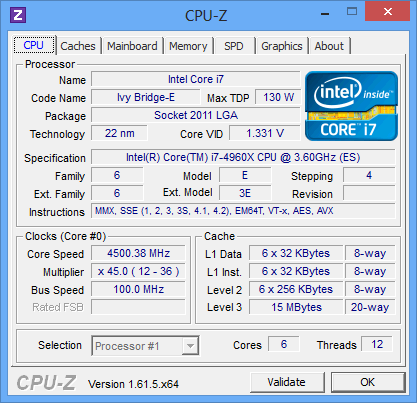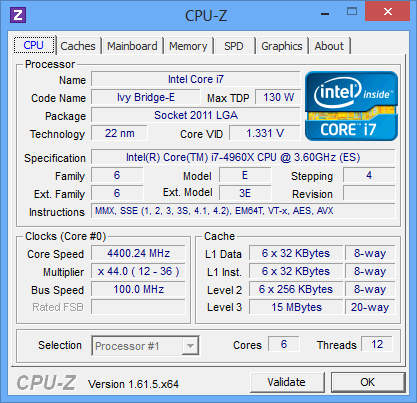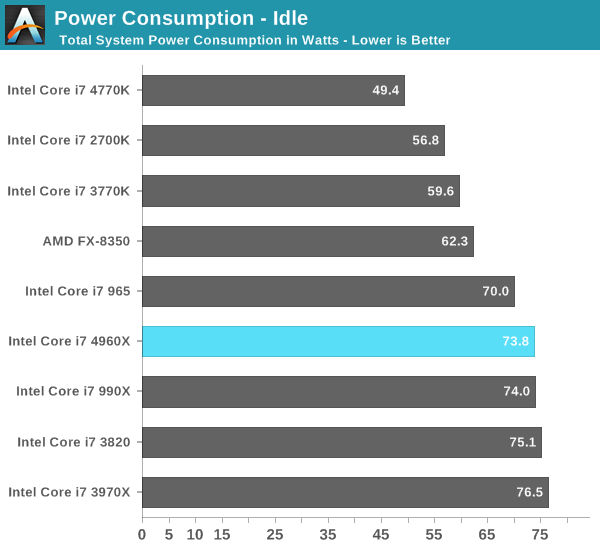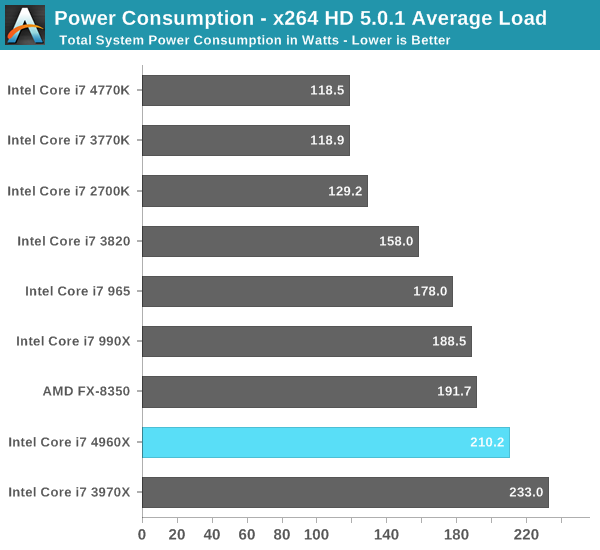Intel Core i7 4960X (Ivy Bridge E) Review
by Anand Lal Shimpi on September 3, 2013 4:10 AM EST- Posted in
- CPUs
- Intel
- Ivy Bridge
- Ivy Bridge-E
Overclocking
As I mentioned earlier, all of the IVB-E launch SKUs ship fully unlocked. Intel offers multipliers up to 63x for you to choose from when overclocking. Like SNB-E before it, IVB-E supports specific BCLK straps (125MHz and 166MHz, in addition to 100MHz) for those overclockers looking to get the absolute most out of their chip. At these overclocked BCLK frequencies, PCIe and other buses are properly divided down so they aren't overclocked (although if you increase the BCLK frequency beyond these strap defaults you will once again be overclocking other buses that derive their frequencies from BCLK). In practice, the cleanest/simplest way to overclock any K-series SKU is by increasing the multiplier.

In our review of the Core i7-3960X I managed a maximum stable overclock of 4.6GHz. I've been told to expect a similar average for Ivy Bridge E. Using Intel's RTS2011LC self contained/closed loop liquid cooling solution I could get into Windows 8 as high as 4.6GHz at 1.42V, however my testbed wasn't stable through all of my tests at that frequency/voltage combination. Moving to higher voltages didn't help, so I had to back down on frequency. I ultimately ended up perfectly stable at 4.3GHz, with 4.4 - 4.5GHz possible with better cooling. The added power needed to hit these frequencies was substantial. I measured a 58W increase in average load power consumption at 4.3GHz/1.4V.

From what I've seen, my sample is a bit on the disappointing side in terms of overclockability. Either way, it doesn't look like you're going to be seeing overclocks significantly higher than what was possible with SNB-E.
Power Consumption
With the 4960X delivering around 5% better performance than the 3970X, the only remaining question is how much more power efficient the move to 22nm made things. Using the same ASUS X79 Deluxe board for both parts, I was able to answer that question.
At idle there's hardly any difference between SNB-E and IVB-E. Under load it looks like IVB-E is good for around a 20W reduction in total system power. It's not an insignificant savings, but definitely not enough to warrant an upgrade if you're on SNB-E already. Anyone looking to migrate to LGA-2011 for the first time will want to go with IVB-E as it is the more thermally efficient solution.












120 Comments
View All Comments
chadwilson - Tuesday, September 3, 2013 - link
Is the IHS soldered or using the cheap termal material? The issue with desktop IB & Haswell overclockability has been proven to be the cheap thermal material between the chip and IHS. If they have a soldered chip to IHS then this will be a decent upgrade over straight IB.BrightCandle - Tuesday, September 3, 2013 - link
Considering the power consumption, clock speed, overclock and temperature obtained its looking most like this is the same interface as SB-E - ie its soldered. Not that it makes much difference as just like SB-E it doesn't actually overclock all that well compared to its 4 core sibling.MrSpadge - Tuesday, September 3, 2013 - link
Look at the results: temperature is not the main problem any more due to the bigger die, but OC is still not good at 4.3 GHz / 1.4 V. Actually I'd say this is ridiculously bad compared to earlier 22 nm chips (my Ivy can do this at ~1.1 V).And I recently got a 3770K which requires 1.11 V to even hit 4.0 GHz! Seems to me Intels current process is to blame for Haswell OC rather than the thermal paste. Sure, temps drop when replacing the paste.. but OC doesn't improve all that much, does it? And if Ivy and Ivy-E don't clock all that well either...
Shadowmaster625 - Tuesday, September 3, 2013 - link
If SNB-E @ 435 mm^2 fit into 130W then they could have made IVB-E @ 435 mm^2 fit into about the same power envelope. If they had to drop the clocks a couple hundred MHz then that's a small price to pay for 10 cores.Kevin G - Wednesday, September 4, 2013 - link
Actually, the core count for the larger Ivy Bridge-E goes up to 12.adamantinepiggy - Tuesday, September 3, 2013 - link
So do these CPU use actual solder under the lid or crappy paste like the 4770K?noeldillabough - Tuesday, September 3, 2013 - link
Oh I've waiting for this! Now the most important question to me...which motherboard is everyone getting an Ivy Bridge-E going to use? I'm doing a custom water cooled loop if that makes any difference.diceman2037 - Tuesday, September 3, 2013 - link
Anand, that marketing image is suffering from a typo, "18% Lower" refers to power utilized, not performance.DMCalloway - Tuesday, September 3, 2013 - link
Wow! 40 PCIe lanes sounds great until you remember skt. 2011 still only supports two 'true' sata3 ports and no native usb3. PCIe storage is never a smooth experience. It's a shame Intel seems unconcerned with power users that are not enterprised based.randfee - Tuesday, September 3, 2013 - link
What a shame these don't support ECC memory! I want it back for the enthusiast!I'm a scientist, what am I supposed to purchase (privately)? I want a beefy machine for physics simulations at home that run for days/weeks i.e. What if a privat person wants to run several VMs?
The E-series would provide nice performance, but no ECC, what a shame!
Right now one has to pick between speed without ECC (chances are the crashes on you) or a chip with relatively slow performance (clock wise) to get ECC, at the same price point. The highend XEON CPUs are out of the question.
@ Anand, please point out to the Intel representatives you meet that there's a market for this! One has to consider AMD at this point, they offer many threads + ECC for a consumer price point. Granted, they're slower, but the premium for the Intel chips with ECC is just out of proportion for private use.